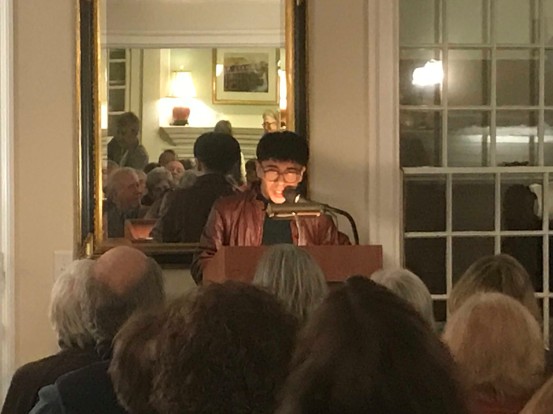By Holly Clay

TS Eliot’s Boyhood Summer Home © 2019 Bing
We shall not cease from exploration. And the end of all our exploring will be to arrive where we started and know the place for the first time.—T. S. Eliot
Several times during the years after poet and Nobel Laureate T.S. Eliot married his second wife Valerie Fletcher, in 1956, they made the trip across the Atlantic from London to Eliot’s family house, high above Niles Beach in East Gloucester. The old summer house on Edgemoore Road had been sold decades before, but Eliot liked paying the house and its new occupants, Mr. and Mrs. John Cahill, a visit. The Cahills recalled the famous poet’s presence while pointing out the room that had once been his. It was the smallest because he was the youngest of six. They also remembered tears in the poet’s eyes as he made his way through its rooms. Each visit brought him down a memory lane flooded with feeling.
Clare Reihill, an Eliot Foundation trustee, says, “Valerie said the home in Gloucester, was the only place he’d ever experienced pure happiness.”
In 1965, after Eliot’s death, Valerie, then 37, became Eliot’s Literary Executrix, dedicating her life to looking after his legacy. She worked with Faber and Faber, the London publishing house aligned with the estate, where Eliot had been a director. While at Faber he founded and edited the prestigious literary journal Criterion, (1922-1939).
After Valerie’s death, Reihill and her co-trustee Judith Hooper found a letter, the contents of which came as a revelation.
“Valerie wanted to buy the Eliot house,” Reihill said. “It had come up for sale in 1965 or 1966. She wrote to her mother, ‘I wonder if I should buy it because he loved it so much.’”
“The letter was such a wonderful thing to discover,” Reihill, said, “a blessing beyond the grave. The connection was so strong, Valerie thought acquiring the house would be consoling for her.”
But Valerie didn’t buy the house. Its $65,000 price tag would have strained her budget. As a consequence, the ties with the United States grew looser.
During his youth, T. S. Eliot and his family divided their time between St. Louis in the Midwest, and Gloucester in New England. Both places abided in Eliot’s psyche, as they did in his writing.
Eliot once commented, “In New England I miss the long dark river, the ailanthus trees, the flaming cardinal birds, the high limestone bluffs where we searched for fossil-shell fish; in Missouri I missed the fir trees, the bay, and the goldenrod, the song-sparrows, the red granite and the blue sea of Massachusetts.”
Reihill says: “Gloucester had a profound influence on Eliot. The place was enormously important to his poetry. His sisters were married here. There was a piece of Eliot’s heart here.”
Gloucester images not only enriched his writing but also “shaped him as a poet,” writes Robert Crawford, author of Young Eliot: From St. Louis to The Waste Land (2016).
“Indeed, maritime images rooted in Gloucester reverberate throughout Eliot’s work,” Crawford writes, “whether it’s ‘the hand expert with sail and oar’ from The Waste Land or ‘the ragged rock in the restless waters’ and ‘the sea is all about us’ in The Dry Salvages, a poem that is itself named for a group of rocks off Cape Ann.
“In Cape Ann,” Crawford continues, “Eliot lists many of the region’s birds — the ‘Swamp-sparrow, fox-sparrow, vesper-sparrow,’ and the house itself even makes an appearance in Ash-Wednesday: ‘From the wide window towards the granite shore/The white sails still fly seaward, seaward flying/Unbroken wings.’”
An acute awareness of his New England ancestry informed Eliot’s thought as well. He once said, “My family was New Englanders…The family guarded jealously its connection with New England…”
And, so, the Eliots returned here, having chosen Gloucester as their summer residence. Initially, they stayed at the nearby Hawthorne Inn. In time, plans took shape for a home, the brainchild of Eliot’s father Henry Ware Eliot (1843-1919). The East Gloucester house at 18 Edgemoor Road, “the Downs,” as the family named it, was completed in 1896. Eliot would have been an impressionable seven or eight years of age.
For the next almost 20 years he would reside here in summers, even “coming up” during his Harvard years. Then came the break. He visited only once between the time of his permanent move to England in 1914 and his father’s death in 1919. The house was sold. Eliot’s mother Charlotte Champe Stearns (1843-1929) said she could no longer afford the upkeep. She was deeply saddened by the loss.
Reihill says, “She was pained” about selling the home, which has since had a number of owners, including the T.S. Eliot Foundation since 2015.
Hooper says, “So now is the fulfillment of a dream,” a dream held by Eliot’s widow and perhaps by Eliot himself.
The acquisition and rehabilitation process is a story in itself.
Hooper and Reihill say it was a “shock” to learn the house was for sale. “Someone sent us the link, ‘T.S. Eliot Summer House for Sale.’ We knew of its existence, but we thought it had been destroyed long ago. It was irresistible because we wanted to forge a new connection with America, a link.
“Sales of Eliot’s works had been lower here in the U.S. His poems, plays, and essays are not on syllabi to the same extent they are in England. He’s a slightly forgotten, slightly problematic figure in America. We’re interested in rehabilitating his reputation and establishing the fact he belonged here.”
Hooper handled the business and legalities of buying the property, as well as overseeing renovations and upgrades.
She says, “The Foundation bought it to be a retreat for writers who could do everything Eliot could do, the full range of craft: essayists, poets, playwrights, critics, editors. The restoration had to do with making it fit a group who weren’t a family. This is a long term thing for us.”
Hooper says, “It was with warmth, the way we were accepted. Anything to do with T.S. Eliot, well, people have been helpful and interested. People here are proud of the connection. I felt welcome, personally, so I want this house to work all the more. Fiona Atkinson, the decorator, and I spent Thanksgiving here with Dana Hawkes, the previous owner and now Director of the Eliot House in Gloucester. Then, I was here for Christmas with my family, before we got going on construction projects. It’s a strange thing to say, but it feels like coming home.”
The Foundation undertook renovations designed to make the house last another 100 years as a destination for writers. The garage extension was converted into a handicap-accessible bedroom and bath, the other baths in the house were upgraded; the house was totally rewired and the interior freshly re-painted.
They worked with local people, for the most part.
Hooper says, “I didn’t realize that ‘local’ meant Gloucester. We actually began by finding professionals over the bridge. That’s a million miles away, I realized, even though it’s only 40 minutes.”
Once she realized how locals define “local,” she tried to contract on Cape Ann or at least nearby. “Fiona, the decorator, shopped in Gloucester, Essex, and Ipswich buying things from antique shops, and dare I say, ‘junk shops.’ We also bought a lot of Dana’s pieces. The sofa in the drawing room was Dana’s. And, all the rugs.”
As a writers’ retreat, “the Downs” constitutes a perfect adaptive re-use for the once-upon-a-time home of a world-celebrated Nobel Laureate. Residents stay an average of two weeks at a time. They work in a variety of genres. The Foundation directors vet applications for residency.
The Eliot House has been accepting writers in residence since 2016. They can accommodate five people and can just fit in a sixth. The foundation supports the whole effort. Hawkes even prepares dinner for the guests.
Hawkes writes, “Last year we had 22 writers residing at the house. The house is open from April to October and is closed during the winter months for now.
“We have had many inquiries about the residencies through word of mouth from those who have stayed with us, along with winners of the Chapbook Award from the Poetry Society of America and the annual Fellowship Prize of the Academy of American Poets. Most of the writers are from the US.
“We have an annual poetry reading to launch the opening of the season’s residency. We also are investigating the idea of having a T.S. Eliot Festival in the foreseeable future.”

Ocean Vuong, recipient of the 2017 T.S. Eliot Prize for his poetry, reads at the Eliot House in the Spring of 2018.
In addition, the Foundation considers “the Downs” to be part of the Gloucester community. As such, Reihill and Hooper would like to see programs developed on the local front.
Hawkes comments: “We would very much like to do something with the local schools. I have made some inquiries with regards to this and the idea is at its infancy – a work in progress. If something is to be done, probably not until 2020.”
Notes:
Thomas Stearns Eliot lived from 1888 to1965. At 25, in 1914, he left the U.S. permanently. In 1927, Eliot became a British citizen, formally relinquishing his U.S. citizenship. He received the Nobel Prize for literature posthumously in 1948.
Judith Hooper and Clare Reihill serve as Trustees of the London-based Eliot Foundation, which maintains close ties with Faber and Faber. Dana Hawkes is the Gloucester-based Director of the Eliot House.
 Holly Clay is settled in Gloucester after many years of living overseas and in Washington, D.C. Holly is a member of the Gloucester Historical Commission and the Annisquam Historical Society. With a background in education and writing, her professional energies are currently devoted to studying and teaching yoga and meditation.
Holly Clay is settled in Gloucester after many years of living overseas and in Washington, D.C. Holly is a member of the Gloucester Historical Commission and the Annisquam Historical Society. With a background in education and writing, her professional energies are currently devoted to studying and teaching yoga and meditation.



 Lori Sanborn was born in Gloucester and returned to live permanently in our seaside community six years ago. She has been a public educator for 12 years and is currently the Assistant Principal of Swampscott Middle School. Lori is most proud of her role as mother to her children, Emerson and Ryder.
Lori Sanborn was born in Gloucester and returned to live permanently in our seaside community six years ago. She has been a public educator for 12 years and is currently the Assistant Principal of Swampscott Middle School. Lori is most proud of her role as mother to her children, Emerson and Ryder.